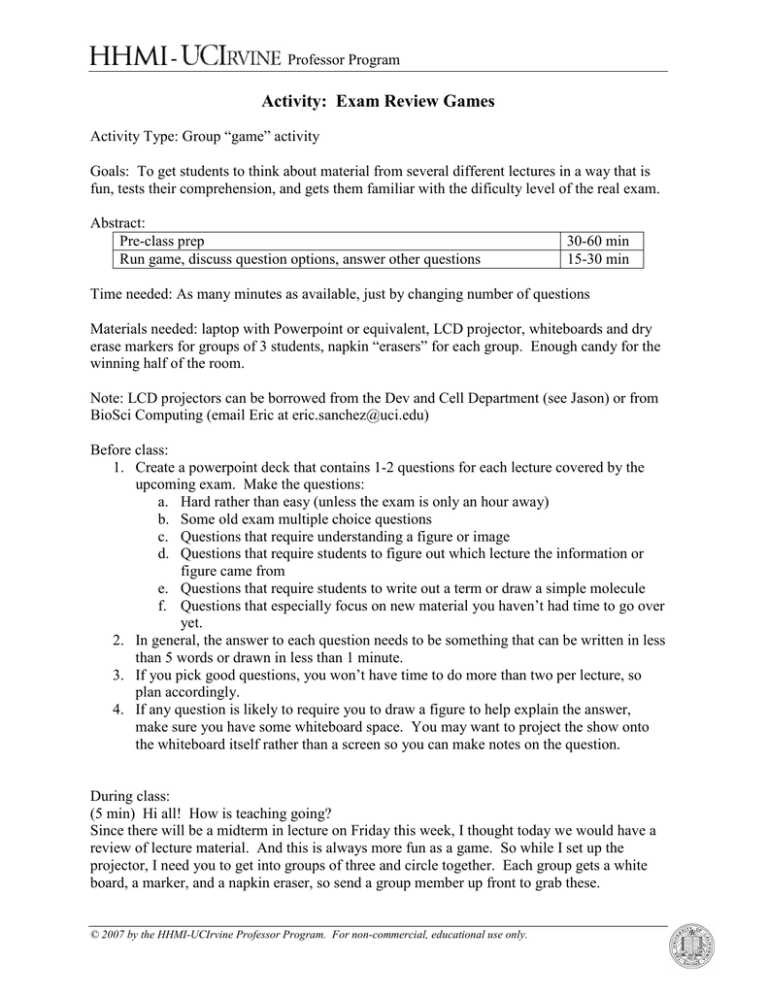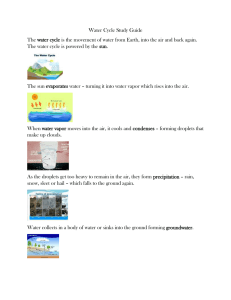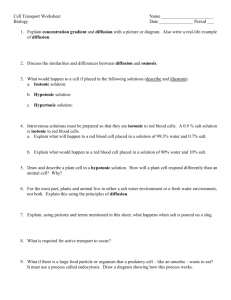Activity: Exam Review Games - HHMI Professor Diane O`Dowd
advertisement

- Professor Program Activity: Exam Review Games Activity Type: Group “game” activity Goals: To get students to think about material from several different lectures in a way that is fun, tests their comprehension, and gets them familiar with the dificulty level of the real exam. Abstract: Pre-class prep Run game, discuss question options, answer other questions 30-60 min 15-30 min Time needed: As many minutes as available, just by changing number of questions Materials needed: laptop with Powerpoint or equivalent, LCD projector, whiteboards and dry erase markers for groups of 3 students, napkin “erasers” for each group. Enough candy for the winning half of the room. Note: LCD projectors can be borrowed from the Dev and Cell Department (see Jason) or from BioSci Computing (email Eric at eric.sanchez@uci.edu) Before class: 1. Create a powerpoint deck that contains 1-2 questions for each lecture covered by the upcoming exam. Make the questions: a. Hard rather than easy (unless the exam is only an hour away) b. Some old exam multiple choice questions c. Questions that require understanding a figure or image d. Questions that require students to figure out which lecture the information or figure came from e. Questions that require students to write out a term or draw a simple molecule f. Questions that especially focus on new material you haven’t had time to go over yet. 2. In general, the answer to each question needs to be something that can be written in less than 5 words or drawn in less than 1 minute. 3. If you pick good questions, you won’t have time to do more than two per lecture, so plan accordingly. 4. If any question is likely to require you to draw a figure to help explain the answer, make sure you have some whiteboard space. You may want to project the show onto the whiteboard itself rather than a screen so you can make notes on the question. During class: (5 min) Hi all! How is teaching going? Since there will be a midterm in lecture on Friday this week, I thought today we would have a review of lecture material. And this is always more fun as a game. So while I set up the projector, I need you to get into groups of three and circle together. Each group gets a white board, a marker, and a napkin eraser, so send a group member up front to grab these. © 2007 by the HHMI-UCIrvine Professor Program. For non-commercial, educational use only. - Professor Program Okay, here’s how the game will work. I’m dividing the groups into this side of the room (motion with hands) and this side of the room. (Pick a talkative student) Jane, will you please be scorekeeper for us? We’ll make this side the “Fighting Pirates” and this side the “Desperados.” I’m going to show you a question, and give you just a minute or two to go over the answer. One person in your group must write the answer on the whiteboard I’ve provided. Then, I will tell all the groups to raise up their boards so the rest of the class can see the answers. You have to raise your board when I say so. The half of the room with the most correct boards will get one point. And at the end of the game, the half with the most points will win candy. Okay? Okay. And before we begin, I will post these slides on the web page after class, so you don’t need to worry about making notes. You can use your book or lecture notes for this quiz, but speed is required so they may not help. Ready? Here’s the first question. (Show first slide). One more minute to answer…. All right. Boards up! If it isn’t up now, it isn’t counted! I see the Pirates had four out of five groups correct, and the Desperados have only three out of five groups correct. So the Pirates get the point for this question. Jane – can you give the Pirates a point? Why is “a” the best answer here? Why are the other answers not as good? Okay, here’s the next question. (Work your way through the slides. If all students get the answer correct, move on to the next question. If some get it wrong, stop and explain the biology and how to attack the problem. Allow students to ask questions about the general course material as you go along.) (end of class) Good job everyone! The winner was team ___. And this was a good exercise to show you what the questions on the exam will be like. Be sure you are doing more than just writing on flash cards and highlighting your book. Instead, try techniques like 1. writie your own figure legends for figures from the notes 2. summarize your lecture notes on blank paper without looking at your notes 3. explain a concept to a roommate or family member or friend Common Mistakes: • Questions are too easy or there are too many of them. The problem with using online templates for Jeopardy or another existing game like Taboo is you are limited by the rules and question types of those games • Some game formats allow shy students to never answer questions, or only make one group think at one time. Design the game so that everyone in the class has to answer each question. The white boards work well for this. © 2007 by the HHMI-UCIrvine Professor Program. For non-commercial, educational use only. - Professor Program Sample questions 6. Celery stalks that are immersed in fresh water for several hours become stiff. Similar stalks left in a salt solution become limp. From this we can deduce that the cells of the celery stalks are An old exam question on a topic students do not understand well. a. isotonic with fresh water but hypotonic to the salt solution. b. hypotonic to both fresh water and the salt solution. c. hypertonic to both fresh water and the salt solution. d. hypertonic to fresh water but hypotonic to the salt solution. e. hypotonic to fresh water but hypertonic to the salt solution. 1. What element of glucose is most important for ATP production? a. electrons b. protons c. oxygen d. carbons I usually show this question without the figure. If many get the answer wrong, I give them this version and allow them to try again. Practice recall of biological terms 2. List the four covalent bonds of the four important biological molecules © 2007 by the HHMI-UCIrvine Professor Program. For non-commercial, educational use only. - Professor Program 4. Where would you expect to find non-polar R groups on this protein? a. X X b. Y c. Z d. X and Y Y e. X and Z Application of a lecture concept to a new situation. Z 5. Draw this amino acid and circle the R group. Practice drawing molecules. I can also ask what the functional group on the R group is, whether it is polar or not. I ask: “What lecture is this from?” I often have a series of these to encourage familiarity with lecture notes, plus encourage them to keep them together and organized in a 3-ring binder for easy access. © 2007 by the HHMI-UCIrvine Professor Program. For non-commercial, educational use only.


